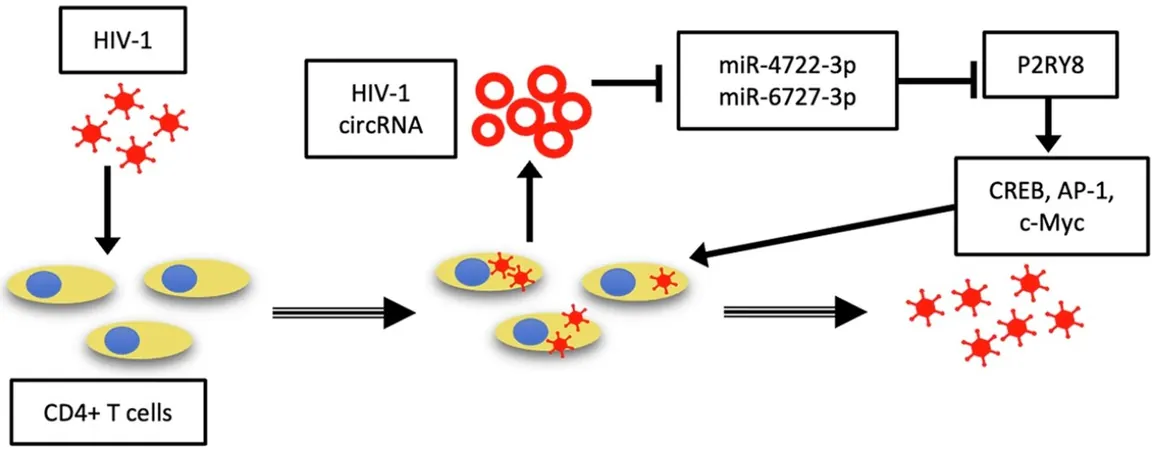
HIV-1 Unleashes a Stealthy Strategy: The Role of Circular RNAs in Evading Immune Defense
2025-05-13
Author: Arjun
Revealing HIV-1's Secret Weapon
In a groundbreaking revelation, researchers from Florida Atlantic University's Charles E. Schmidt College of Medicine have uncovered an unprecedented mechanism that allows the notorious HIV-1 to sidestep the body’s immune response, ensuring its survival and replication.
What Are Circular RNAs?
This newfound tactic revolves around circular RNAs (circRNAs)—unique structures that form loops rather than the straight lines typical of regular RNA molecules. This circular formation grants circRNAs remarkable stability, enabling them to function like sponges, soaking up microRNAs (miRNAs) and thwarting their ability to regulate gene expression.
A New Perspective on HIV-1's Biology
While circRNAs have been identified in many human and animal cells, only a limited number have been discovered in viruses, primarily larger DNA viruses like herpes. However, the latest findings, published in the journal npj Viruses, present the first evidence of HIV-1 generating circRNAs from its integrated retroviral genome—offering a fresh perspective on its biology.
The Masked Life Cycle of HIV-1
This research sheds light on a hidden aspect of HIV-1’s life cycle, illustrating how it boosts its replication and enhances its ability to evade immune detection. It opens up exciting possibilities for new therapeutic targets against one of the most resilient viruses known to mankind.
Expert Insights on the Discovery
"Seeing circular RNAs produced by an RNA virus like HIV-1 is incredibly exciting," stated Dr. Massimo Caputi, the lead researcher. "HIV-1's ability to integrate into the host genome and take control of the cell's RNA-processing machinery is unparalleled among RNA viruses, allowing it to create these stable circumferences."
How HIV-1 Outsmarts the Immune System
The research team pinpointed at least 15 distinct circRNAs generated by HIV-1, confirming their existence using cutting-edge molecular techniques. When HIV infiltrates the body, immune cells, specifically CD4+ T cells, increase levels of two miRNAs—miR-6727-3p and miR-4722-3p—aiming to combat the virus. Interestingly, HIV-1 counters this defense by producing circRNAs that capture these miRNAs, effectively weakening the immune response and facilitating its replication.
Unlocking the Mysteries of CircRNAs
One prominent circRNA, dubbed Circ23, includes segments of the virus's genetic code that were previously misunderstood but now appear crucial for HIV's survival. This suggests that circRNA production may vary among individuals, potentially explaining differing responses to the virus, particularly during its dormant state.
Towards a Cure: Future Research Directions
Although current technologies for measuring circRNAs are challenging, advances like droplet digital PCR are expected to enable precise quantification in patient samples. Dr. Caputi emphasizes, "This is just the beginning. We aim to investigate how these viral circRNAs interact with human cells. If we can find a way to block their effects, we could move significantly closer to a cure."
Innovative Treatment Approaches on the Horizon
The research team plans to explore new treatment methods using antisense oligonucleotides (ASOs) designed to target and block HIV's circRNAs. Testing these strategies in models of long-term infection and in cells from individuals living with HIV could further clarify how these circRNAs help the virus endure.
New Frontiers in HIV Research
As the study unravels the intricate ways HIV commandeers human cells, it uncovers new avenues for treatment. The stability and specificity of circular RNAs might not only serve as markers of infection but could also emerge as novel targets for drug development, paving the way for future therapeutic breakthroughs.


 Brasil (PT)
Brasil (PT)
 Canada (EN)
Canada (EN)
 Chile (ES)
Chile (ES)
 Česko (CS)
Česko (CS)
 대한민국 (KO)
대한민국 (KO)
 España (ES)
España (ES)
 France (FR)
France (FR)
 Hong Kong (EN)
Hong Kong (EN)
 Italia (IT)
Italia (IT)
 日本 (JA)
日本 (JA)
 Magyarország (HU)
Magyarország (HU)
 Norge (NO)
Norge (NO)
 Polska (PL)
Polska (PL)
 Schweiz (DE)
Schweiz (DE)
 Singapore (EN)
Singapore (EN)
 Sverige (SV)
Sverige (SV)
 Suomi (FI)
Suomi (FI)
 Türkiye (TR)
Türkiye (TR)
 الإمارات العربية المتحدة (AR)
الإمارات العربية المتحدة (AR)